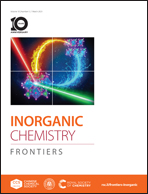Tetranuclear lanthanide complexes display significant slow magnetic relaxation with an open hysteresis loop and the magnetocaloric effect†
Abstract
Two tetranuclear lanthanide complexes with the formulas [Dy4(HL)4(OAc)2(H2O)2]·2Et3NH·2CH3CN (1) and [Gd4(HL)4(OAc)2(H2O)2]·2Et3NH·2CH3OH·4CH3CN (2) (H4L = N,N′-bis(3-hydroxylsalicylidene)benzene-1,2-diamine) were structurally and magnetically characterized. Dynamic magnetic studies revealed that complex 1 exhibits two distinct slow magnetic relaxation processes under a zero direct current (dc) field and the extracted energy barriers (Ueff) of the low-temperature and high-temperature relaxation processes reach 207(2) K and 353(3) K, respectively, which are among the highest Ueff values of reported tetranuclear dysprosium molecular nanomagnets. More strikingly, as for complex 1, the open hysteresis loop behavior is detected until 5 K (6.5 K for the diluted sample), and a coercive field of 453 Oe is observed at 1.8 K, which is unusually seen in tetranuclear lanthanide single-molecule magnets. Further magnetic studies of diluted samples combined with ab initio calculation indicate that the DyIII–DyIII interactions play a crucial role in suppressing quantum tunneling of magnetization and consequently resulted in the bulk magnet-like hysteresis behavior. Additionally, the Gd-congener 2 displays the magnetocaloric effect (MCE) with a magnetic entropy change (−ΔSm) of 20.8 J kg−1 K−1 at 2 K for ΔH = 7 T.



 Please wait while we load your content...
Please wait while we load your content...